Teach you how to implement a duty robot using Golang and lua
The following column golangtutorial will introduce to you how to use Golang and lua to implement a duty robot. I hope it will be helpful to friends in need!

One of the tasks of our project team is to collect emails (to a large extent, we use emails to save money), and then check them from our system. Check out the relevant information and then reply to the email. Although the workload is not large, it will cut the time into small pieces. In order to save my time, I made an email robot on duty. I asked him to automatically reply to emails on my behalf. Considering that many people should be able to use this thing, I shared it. Let’s share the effect first.
It’s very simple on the server. Dutyrobot is the framework compiled by Golang. The lua folder contains business logic written in lua. Data.json saves some relevant data to prevent data from being lost after restarting, such as cookie information.

Use the most basic alpine to start, map the relevant folders to the container, and then start the software in the container. This is mainly done so that the image can have its own environment variables.

Then the business logic regularly receives emails, then determines the business logic, executes the corresponding lua script, and then replies to the email.
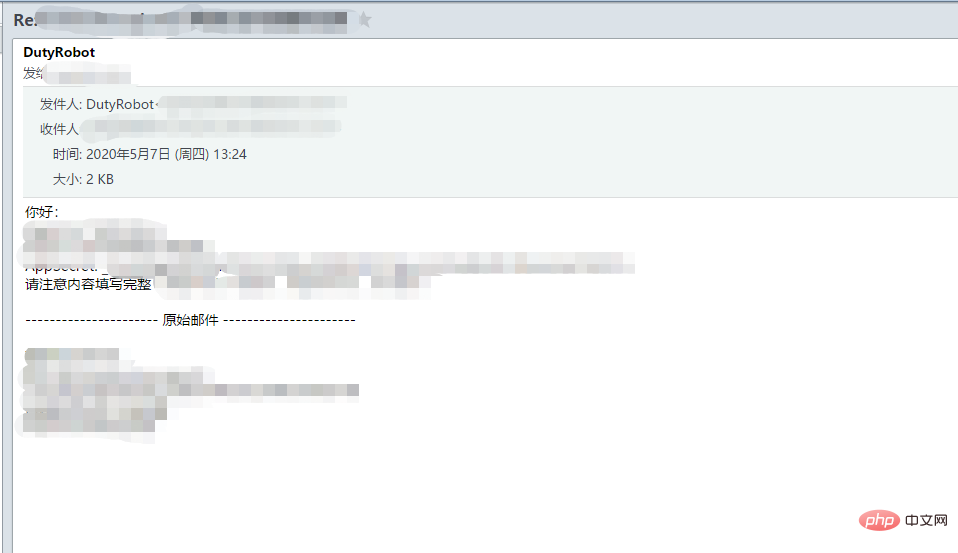
Just push a related result to our internal affairs group.

Actually, I am a C# programmer. To do this, I first used C# to implement it. However, C# and Lua are not compatible, and I have not found a more elegant class library. To use Linux system, I have tried using .net core C to call Lua, but I am still very naive about this matter. I was confused by the installation of various Python packages. So in the end, I chose Golang to write the underlying functions and publish them to Lua, and then let Lua write various business logic to implement the entire project. As for the framework part, once it is written, the probability of changes is relatively low, and cross-compiling Linux with Window can be deployed and launched directly without even installing an environment, which is really cool. The lua interpreted language is pretty good except for nothing.
The basic framework is universal, so it can be released and used directly. Just care about your business content.
Basic framework: https://gitee.com/anxin1225/DutyRobotGo
In this framework, I provide many functions for lua, mainly including sending and receiving emails, initiating network requests, and initiating Network monitoring (you can even use this as the bottom layer to make a small API station, trust me, I have done this before), temporarily save data, obtain environment variables, obtain file contents, and then start a Lua container (yes, lua The ability to create a Lua container again), obtain current system information, and cron scheduled tasks. Of course, if you feel it's not enough, you can also expand it a second time. It's actually very easy. I've already written a lot of it. I'll compare it and copy it. It's very easy. However, in general, there is no need to expand. I will not explain the framework part in depth here. After all, how to do business is the focus.
Then, let’s talk about how the Lua part is implemented. Because the code in Golang directly finds main.lua for execution, we will start from this file.
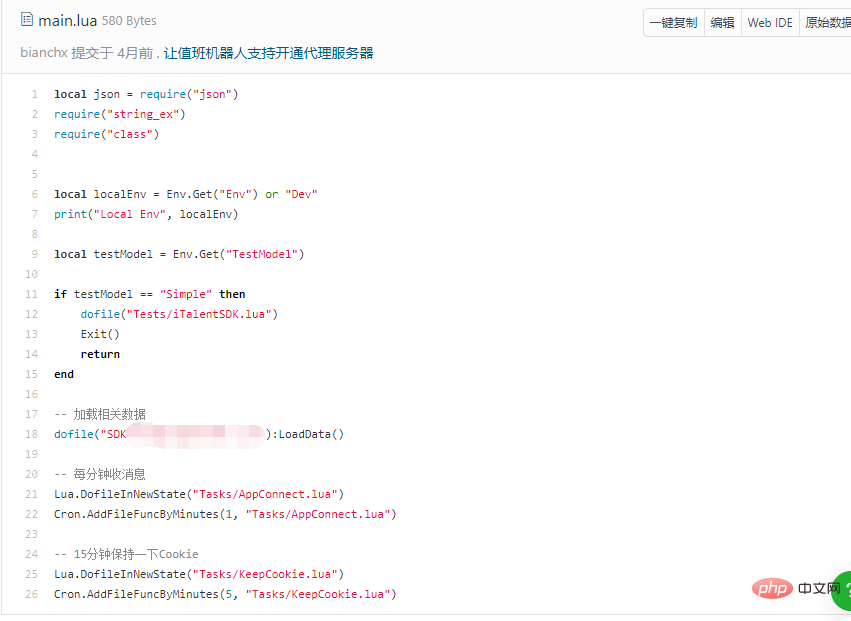
I have registered many services. As for what services there are, I still have to look at how they are written in the framework. Cron is one of the small functions I wrote. In fact, it is a task task. Corresponding to the framework part, you can check the tasks folder to see the specific implementation. You can see that there are two files on both sides. Among them, task.go is the language function of Golang. task_4lua.go is to expose the function of Golang. The registered location of the interface called by Lua.

Let’s take a look at the file task_4lua.go. There is usually a function called RegisterFunc_4lua for registration.
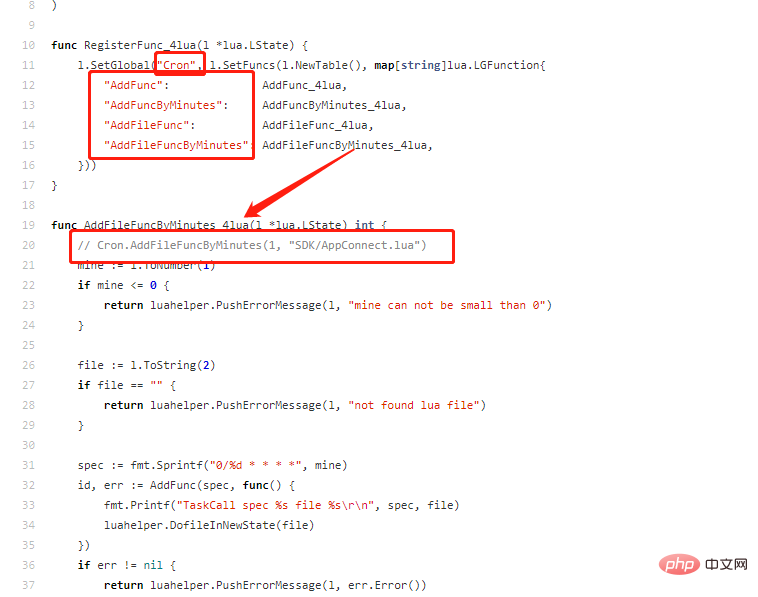
This looks very familiar. Cron is the name of the class used by Lua. The map below is the corresponding name that needs to be called. The following will be compared with the functions on the golang side. Generally, I will write the Lua side in the function. How should it be called. If you can't find it, you can come to the frame and look around. You might be surprised.

In my business. Just receive it every minute and save the cookie every 5 minutes. The real business logic is actually written in each Lua file. Let's take a look at how to receive and process messages.
Here is the simple business logic of Lua. Receive the email and then call the corresponding processing Lua. Once the processing is completed, you are done.
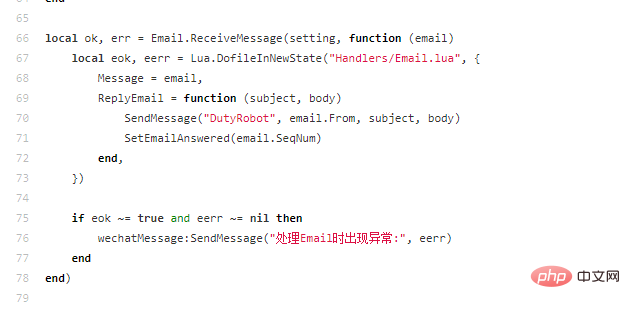
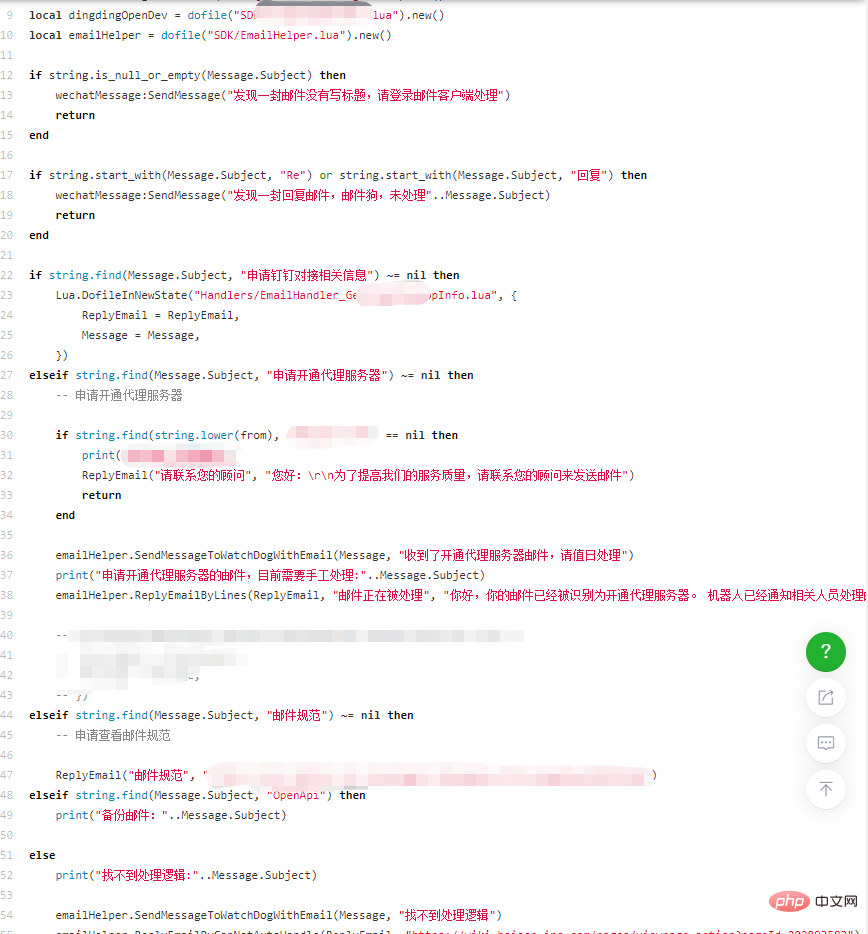
The above is the detailed content of Teach you how to implement a duty robot using Golang and lua. For more information, please follow other related articles on the PHP Chinese website!

Hot AI Tools

Undresser.AI Undress
AI-powered app for creating realistic nude photos

AI Clothes Remover
Online AI tool for removing clothes from photos.

Undress AI Tool
Undress images for free

Clothoff.io
AI clothes remover

AI Hentai Generator
Generate AI Hentai for free.

Hot Article

Hot Tools

Notepad++7.3.1
Easy-to-use and free code editor

SublimeText3 Chinese version
Chinese version, very easy to use

Zend Studio 13.0.1
Powerful PHP integrated development environment

Dreamweaver CS6
Visual web development tools

SublimeText3 Mac version
God-level code editing software (SublimeText3)

Hot Topics
 How to safely read and write files using Golang?
Jun 06, 2024 pm 05:14 PM
How to safely read and write files using Golang?
Jun 06, 2024 pm 05:14 PM
Reading and writing files safely in Go is crucial. Guidelines include: Checking file permissions Closing files using defer Validating file paths Using context timeouts Following these guidelines ensures the security of your data and the robustness of your application.
 How to configure connection pool for Golang database connection?
Jun 06, 2024 am 11:21 AM
How to configure connection pool for Golang database connection?
Jun 06, 2024 am 11:21 AM
How to configure connection pooling for Go database connections? Use the DB type in the database/sql package to create a database connection; set MaxOpenConns to control the maximum number of concurrent connections; set MaxIdleConns to set the maximum number of idle connections; set ConnMaxLifetime to control the maximum life cycle of the connection.
 Comparison of advantages and disadvantages of golang framework
Jun 05, 2024 pm 09:32 PM
Comparison of advantages and disadvantages of golang framework
Jun 05, 2024 pm 09:32 PM
The Go framework stands out due to its high performance and concurrency advantages, but it also has some disadvantages, such as being relatively new, having a small developer ecosystem, and lacking some features. Additionally, rapid changes and learning curves can vary from framework to framework. The Gin framework is a popular choice for building RESTful APIs due to its efficient routing, built-in JSON support, and powerful error handling.
 What are the best practices for error handling in Golang framework?
Jun 05, 2024 pm 10:39 PM
What are the best practices for error handling in Golang framework?
Jun 05, 2024 pm 10:39 PM
Best practices: Create custom errors using well-defined error types (errors package) Provide more details Log errors appropriately Propagate errors correctly and avoid hiding or suppressing Wrap errors as needed to add context
 How to save JSON data to database in Golang?
Jun 06, 2024 am 11:24 AM
How to save JSON data to database in Golang?
Jun 06, 2024 am 11:24 AM
JSON data can be saved into a MySQL database by using the gjson library or the json.Unmarshal function. The gjson library provides convenience methods to parse JSON fields, and the json.Unmarshal function requires a target type pointer to unmarshal JSON data. Both methods require preparing SQL statements and performing insert operations to persist the data into the database.
 How to solve common security problems in golang framework?
Jun 05, 2024 pm 10:38 PM
How to solve common security problems in golang framework?
Jun 05, 2024 pm 10:38 PM
How to address common security issues in the Go framework With the widespread adoption of the Go framework in web development, ensuring its security is crucial. The following is a practical guide to solving common security problems, with sample code: 1. SQL Injection Use prepared statements or parameterized queries to prevent SQL injection attacks. For example: constquery="SELECT*FROMusersWHEREusername=?"stmt,err:=db.Prepare(query)iferr!=nil{//Handleerror}err=stmt.QueryR
 Golang framework vs. Go framework: Comparison of internal architecture and external features
Jun 06, 2024 pm 12:37 PM
Golang framework vs. Go framework: Comparison of internal architecture and external features
Jun 06, 2024 pm 12:37 PM
The difference between the GoLang framework and the Go framework is reflected in the internal architecture and external features. The GoLang framework is based on the Go standard library and extends its functionality, while the Go framework consists of independent libraries to achieve specific purposes. The GoLang framework is more flexible and the Go framework is easier to use. The GoLang framework has a slight advantage in performance, and the Go framework is more scalable. Case: gin-gonic (Go framework) is used to build REST API, while Echo (GoLang framework) is used to build web applications.
 What are the common dependency management issues in the Golang framework?
Jun 05, 2024 pm 07:27 PM
What are the common dependency management issues in the Golang framework?
Jun 05, 2024 pm 07:27 PM
Common problems and solutions in Go framework dependency management: Dependency conflicts: Use dependency management tools, specify the accepted version range, and check for dependency conflicts. Vendor lock-in: Resolved by code duplication, GoModulesV2 file locking, or regular cleaning of the vendor directory. Security vulnerabilities: Use security auditing tools, choose reputable providers, monitor security bulletins and keep dependencies updated.






